Invertebrate Zoology Exam 3
1/37
There's no tags or description
Looks like no tags are added yet.
Name | Mastery | Learn | Test | Matching | Spaced |
|---|
No study sessions yet.
38 Terms
Phylum Mollusca
Soft-bodied
Over 100,000 species, body plan is diverse
Features
Dorsal epithelium (mantle) - secretes shell
Radula - used for feeding
Ventral epithelium - forms “foot”
Mollusc Features
Mantle - specialized epithelium for shell
Nacreous layer - base layer, thin and smooth, pearl formation
Central prismatic layer - thick and tough
Periostracum - outer layer, organic, textured
Mantle cavity - between mantle and viscera, contains ctenidia (gills): respiratory function/digestion, reproduction
Osphradium - chemoreceptor
Coelom (body cavity) - small, reduced, surrounds heart/gonads
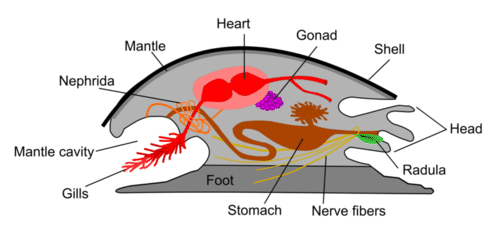
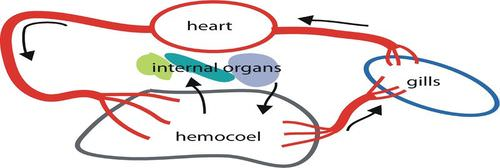
Mollusc Circulatory System
Circulatory system - variation, some closed, most open
Series of sinuses from hemocoel (blood-filled body cavity)
Heart pumps fluid - no pigment, some hemoglobin (iron)
Some hemocyanin in blood (copper)
Gas exchanged a gills: counter current exchange
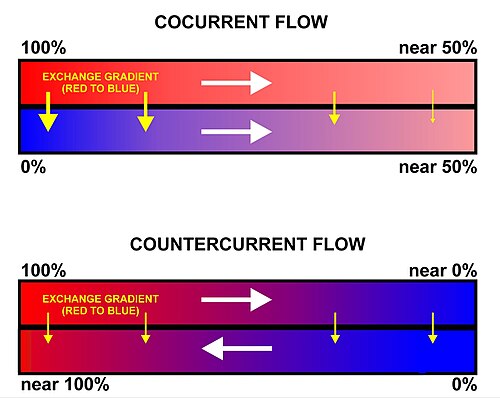
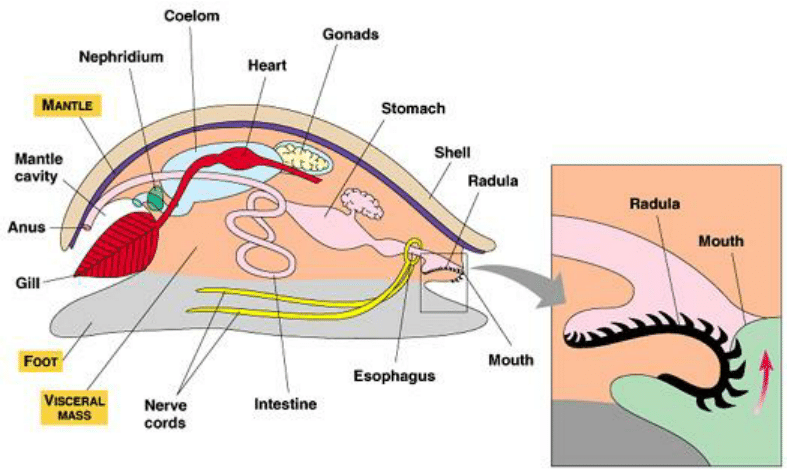
Mollusc Digestive System
Radula in mouth (ribbon of teeth), digestion is complete (mouth to anus)
Teeth are chitinous
Odontophore - under radula, cartilage like, attached to musculature = forms buccal mass/odontophore complex
Rasp food from substrate or boring
Digestion is aided by digestive gland enzymes and storage
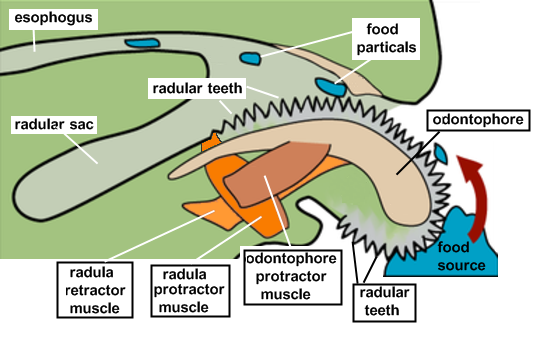
Mollusc Excretory System
Removes metabolic wastes from cells
Waste is dissolved in fluid
Osmoregulation - water + salt homeostasis
Excretory system rids excess water, ions, and toxins
Excretion in different species is done via ammonia (choice of most molluscs), urea, or uric acid
Ammonia - requires more water to excrete, but less energy
Urea and Uric acid - save water, less toxic, require more water
Types of excretion:
Osmoconformers - balance with environment, diffusion + osmosis, used in the ocean
Osmoregulators - homeostatic mechanisms, consistent concentrations despite outer environment
Nephridial systems:
Protonephridia - flame cells, one one opening
Molluscs - metanephridia: internal/external opening, funnel collects, nephridiopore releases

Mollusc Reproduction
Typically dioecious
Hermaphrodism - simultaneous protandric (born as males, but later turn into female)
Ovotestis + reciprocal copulation
Fertilization can be internal or external
Reproduction can be sexual or asexual: Asexual - lacks diversity, more energy efficient Sexual - energy needed to find mate, only use half of each parent’s DNA, creates diversity
Molluscs display sophisticated reproduction
Hectocotylus arm - the modified, specialized arm of a male octopus used to transfer sperm to the female
Love darts - calcareous or chitinous darts that transfer a mucus containing hormones
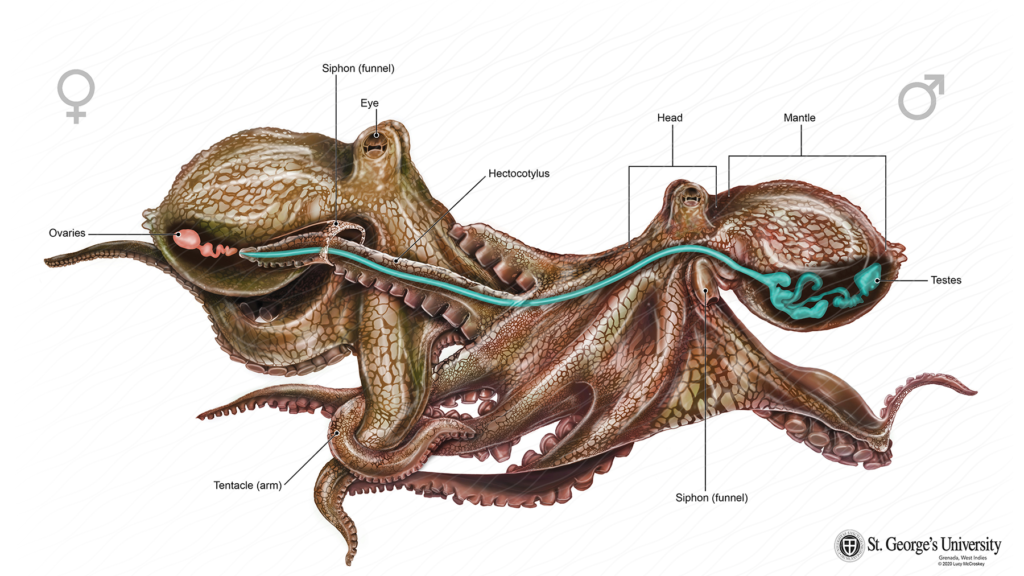
Mollusc Development
Larval stages can be seen sometimes
Trochophore larvae - disperse (free-swimming, ciliated larvae)
Can develop to veliger - feeding
Bivalves modified veliger - glochidia
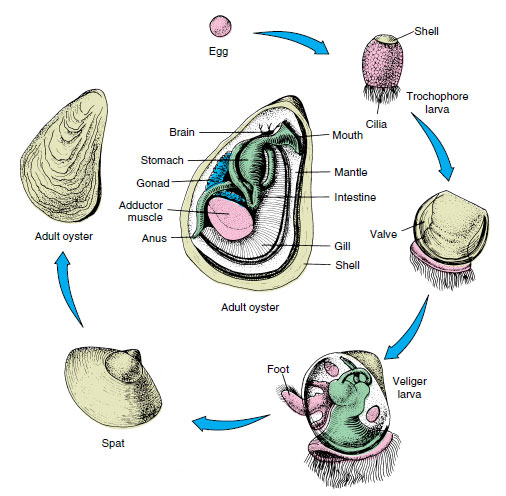
Mollusc Nervous System
Brain
Model system for nerve impulses - giant fibers

Class Aplacophora
“Not plate bearing”
Might be ancestoral
Cylindrical and vermiform (worm-like)
Food formed as keel
Marine, in sediment
No shell (have calcareous “spicules), foot is reduced, no fossil record
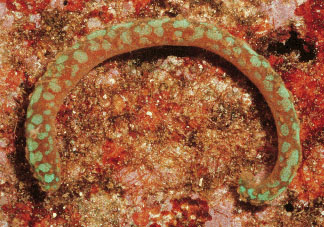

Class Polyplacophora
“Many plate bearing,” chitons
800 species
Marine, intertidal areas
Shell: 7-8 interlocking plates
Thick and flattened mantle (girdle) - used for suction
Calcareous spicules in skin
Water flows through body on both sides, over gills
Linear (straight) digestive tract, full digestive tract, odontophore complex
Ladder-like nervous system
Sensory (photo, chemo, mechano receptors)
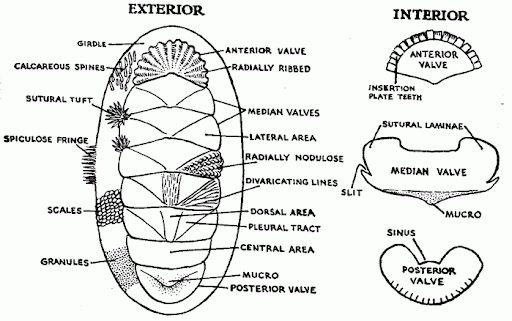
Class Monoplacophora
“One plate,” one valve
Marine, 31 species
Paired structures, 3-6 ctenidia (gills) pairs, 6-7 pairs of nephridia, 8 pairs of retractor muscles
Linear digestive tract
Flattened foot with one shell
Ancestor of “advanced molluscs”
Variation on single shell
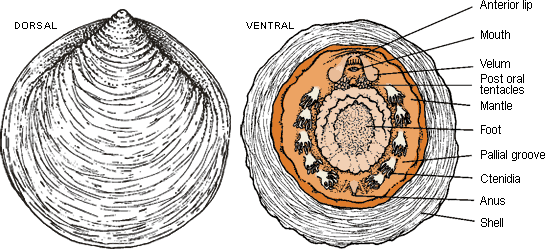
Class Gastropoda
“Stomach foot,” largest class of molluscs
60,000 species, found everywhere, do everything
Visceral mass: twisted 90-180°, on top of foot, covered by “univalve”
Operculum on foot (some), disc that allows the body to be retracted and the shell to seal
Shell in whorls around columella (central axis), sinistral (opening on left) or dextral (opening on right)
Twisting of body = torsion, gills and anus are anterior, no clear reason (potentially sensory)
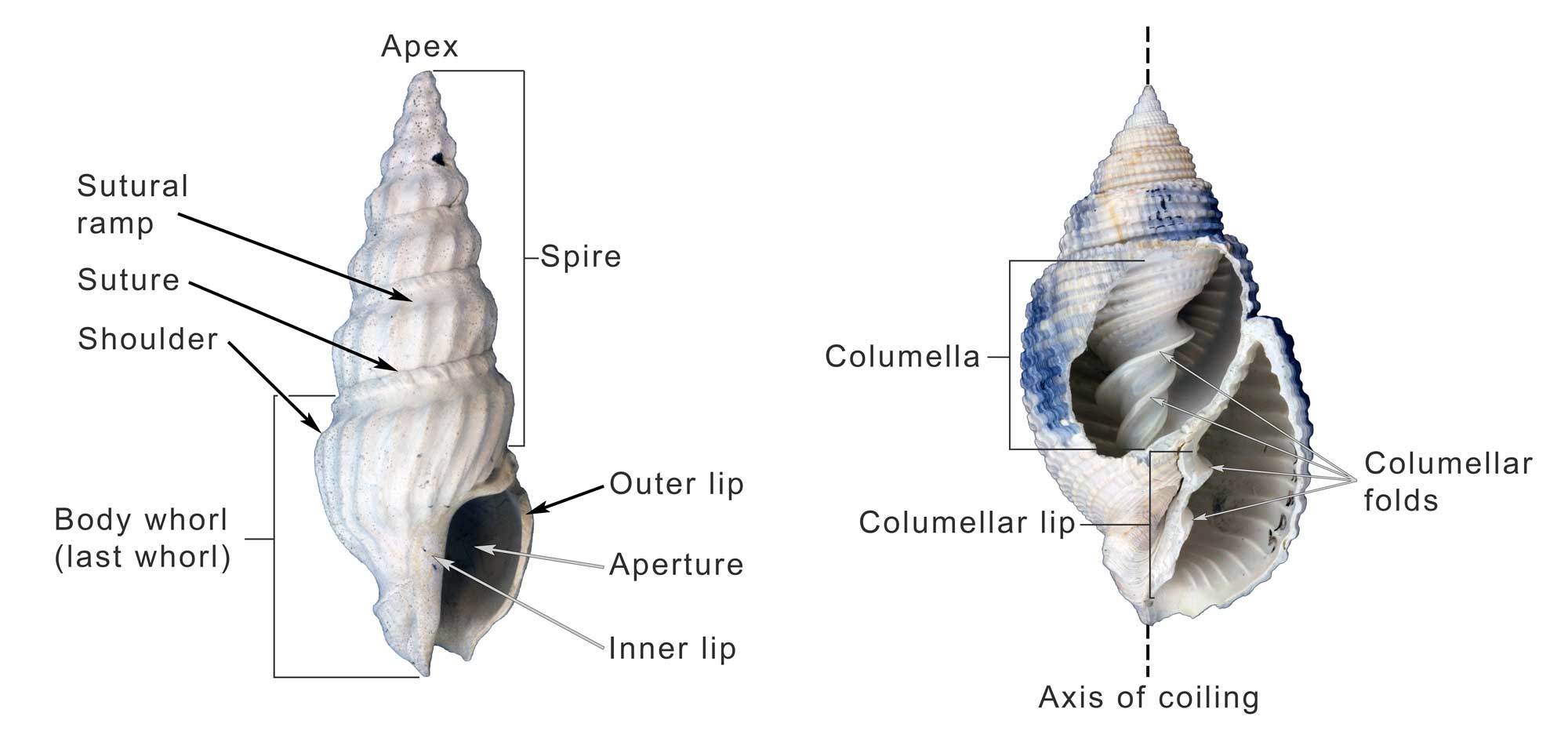
Subclass Prosobronchia (Prosobranchs)
35,000 species
Marine
Cone snails, many threatened (mainly due to shell collectors)
Many venomous (potential applications in medical research)
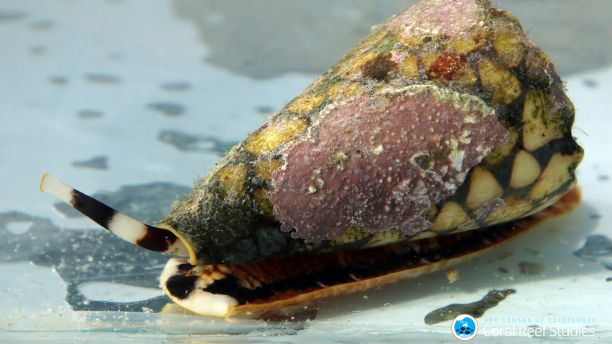
Subclass Opisthobranchia (opisthobranchs)
“Posterior gills”
Linear digestive tract
Lost features - shell, operculum, mantle cavity, reduced gills
Sea slugs/nudibranchs
Sea hares
Sea butterflies - have parapodia/pteropods
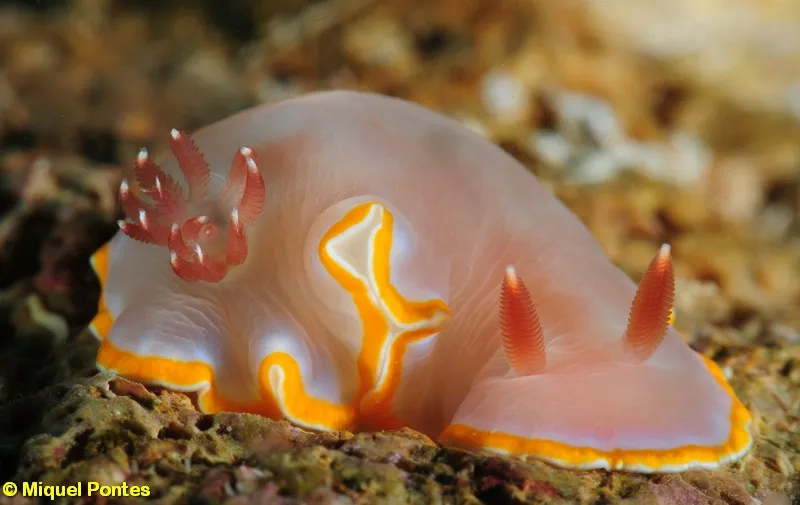
Pulmonata
“Lung snails,” terrestrial snails + slugs
Vascular mantle cavity - “lung”
Some ciliary movement, but largely through pedal waves
Can only move forward, uses a mucus trail
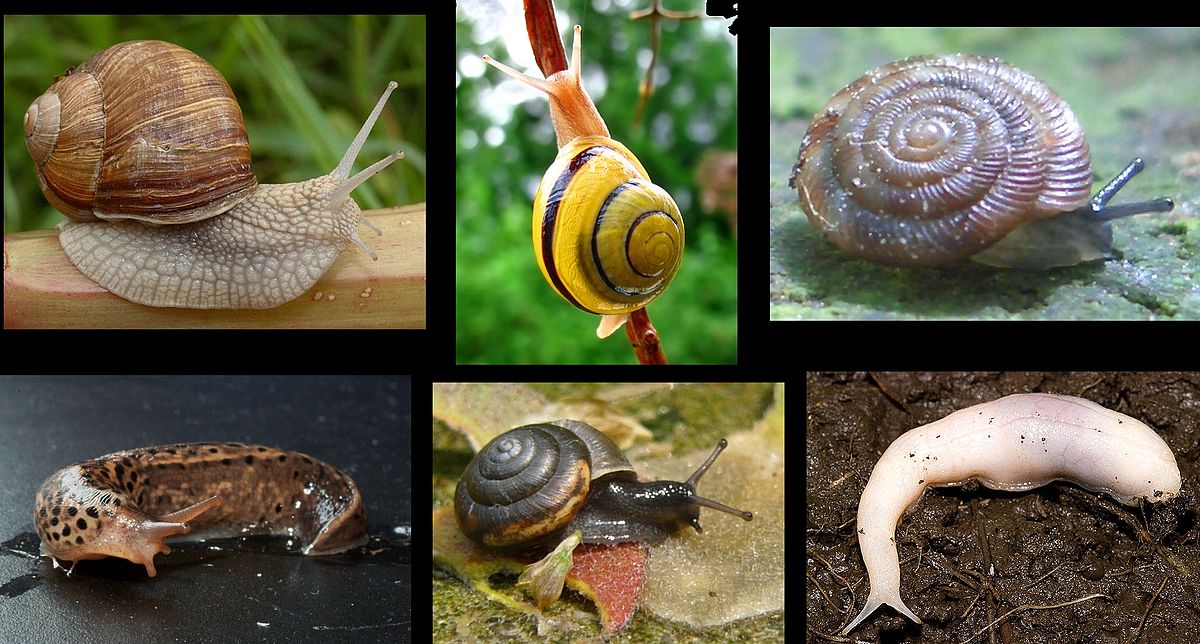
Class Bivalvia (bi-valves)
Includes clams, scallops, mussels
Features - two shells closed by adductor muscles
Laterally flattened
“No” head
Large mantle cavity
Sedentary
No radula, suspension feeders - gill cilia draw water into mantle and filter it

Subclass Protobranch
“First gill” - gills like gastropods
Food collected by palp proscides and labial palps
Gills for respiration
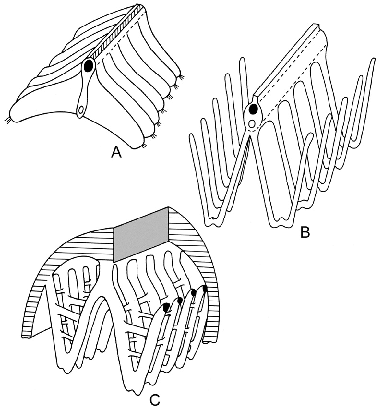
Class Lamellibranchia (Lamellibranchs)
“Plate gills”
Gills for gas exchange/feeding
Byssal threads = used for attachment, encrusts them to surfaces, potential industrial use as glue
Many freshwater species in this group, many reproduce through “vampire” larvae that attach to fish gills (glochidia larvae)
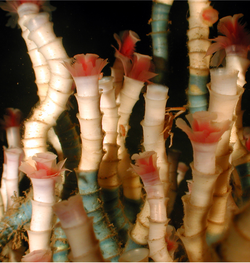
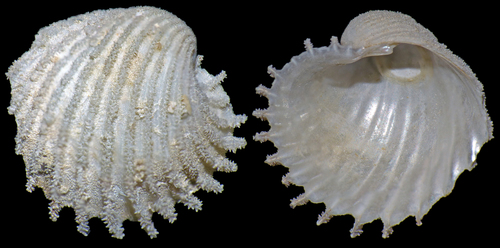
Superorder Anomalodesmata
“Irregular ligament”
Hinge lacks “teeth”
Septibranch type gills
Due to their carnivorous diet, have chitin in the stomach/gills that grinds prey
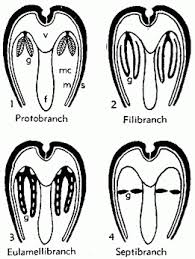
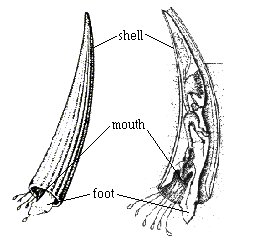
Class Scaphopoda
“Spade foot,” tusk shells
Tubular
Anterior feeding tentacls
No gills or heart, foot pumps fluids
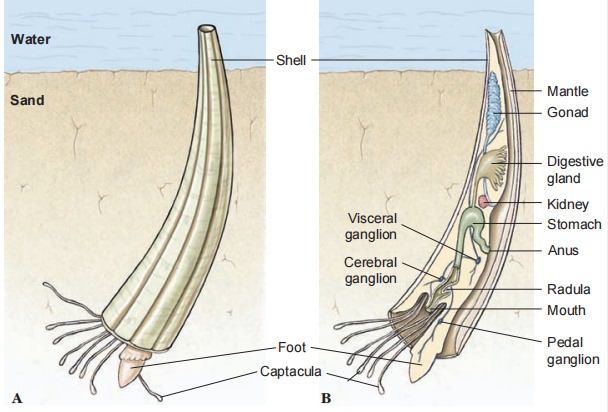
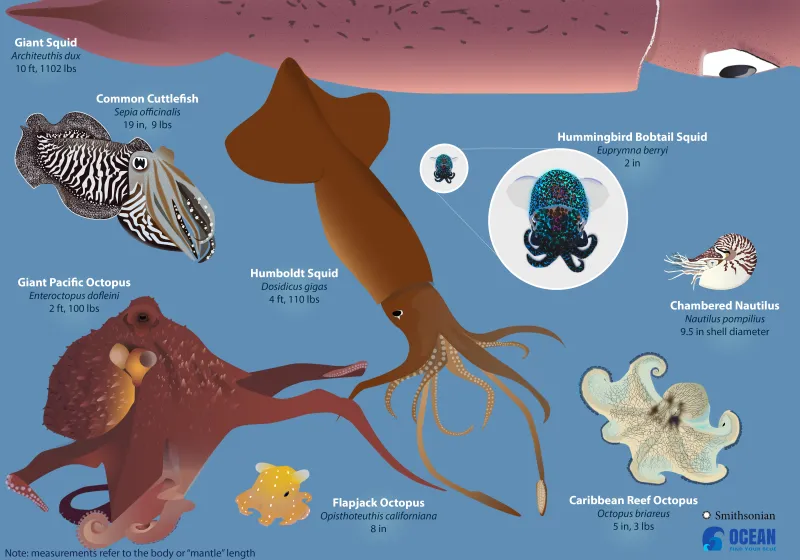
Class Cephalopoda (Cephalopod)
“Head foot,” includes octopi, squid, cuttlefish, and nautilus
Distinct head (cephalization)
Reduced/absent/chambered shell
Closed circulatory system
Foot is highly modified
True brain, enclosed by cartilage
Radula + ctenidia modified
Active predators/complex behaviors
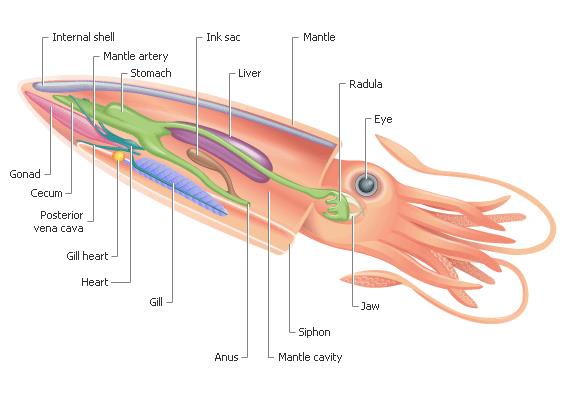
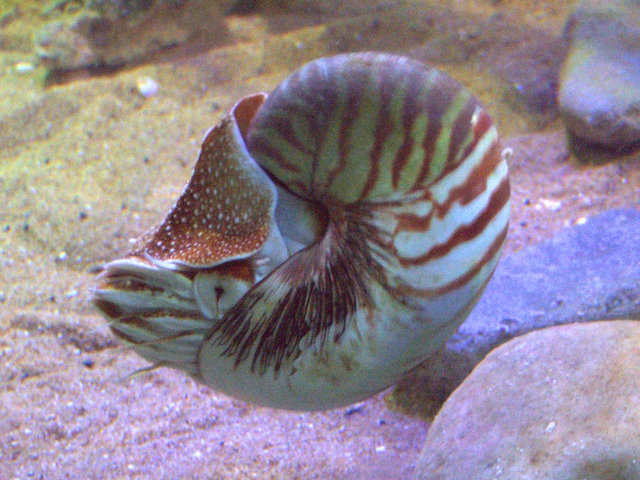
Nautilus (genus)
More ancestorial, shell is highly adapted
Shell is chambered, used for buoyancy
Septa, siphuncle runs through it (controls buoyancy)
Locomotion by the ejection of water
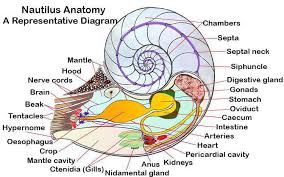
Cephalopod Features
Locomotion by arms/fins
Shell is internal
No shell protection - intelligence, toxins, camo, and tools used for defense
Camo = chromatophores
Single, systemic heart with brachial (gill) hearts
No countercurrent exchange or cilia in gills
Muscles of the mantle flood the cavity (used for gas exchange)
Cephalopods are deaf, may be a defense against predators like whales


Phylum Annelida (Annelids)
Derived group with spiral cleavage
Segmented worms
One or more setae (chitinous spines)
Metamerism - body is segmented, organs are in repeating units, seen in chordates/arthropods also
Septa separate segments, sheet of mesoderm lines interior (triploblastic), creates peritoneum that lines the interior body cavity (coelom) \
Individual segments form a hydrostatic skeleton
Flexible body wall - circular/longitudinal muscles
Body wall is used in gas exchange, moisture is required
Elaborate excretory system, metanephridia (open at both ends) front = nephrostome, pulls coelomic fluid in, runs it through tubules (resorption, osmoregulation)
Waste released out nephridia pore (gametes also released from here, gonads are often reduced, gametes are derived from peritoneum)
Larvae with protonephridia (excretory organ that filters waste and excess water)

Class Polychaeta
“Many setae”
65% of annelid species
Marine
Parapodia - outfolding of body wall, increases surface area, used for gas exchange/locomotion
Parapodia are integrated with the skeleton, muscles attached
Internal chitinous rods (acicula), work with setae, prevent sliding
Pair of eyes, sensory projections on the head, elytra plates (protective plates)
Have a well-developed head, jaws, and muscular pharynx
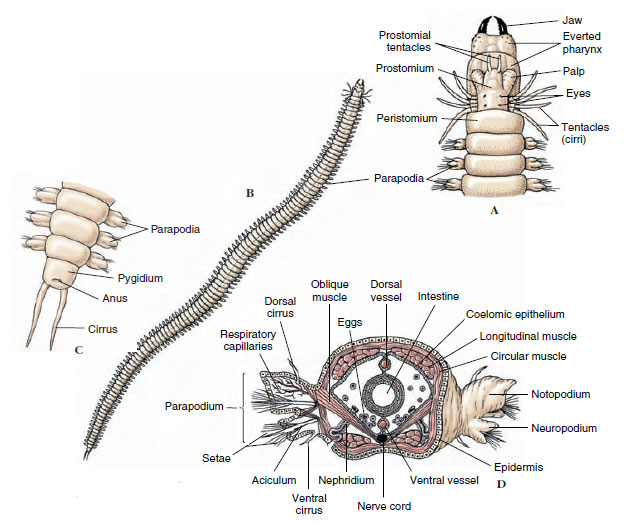
Polychaete Groups
Two groups - errant and sedentary
Errant - move through sinusoidal waves
Sedentary - lost/reduced/modified parapodia
Sedentary Polychaetes
Live in burrows/tubes, secretions + substrates
Parapodia for water movement - feeding, breathing, and waste disposal
Some have feathery radioles (feathery, tentacle-like structures that are used for respiration and filter feeding)
Larvae is used for dispersal
Reproduction - discrete sexes, gametes from peritoneum
Epitoky - specialized, swimming form, epitokes bud off and the atoke is left behind
Triggers are complex
Fertilization - usually external = trochophore larvae (free-swimming larvae)
“Wheel bearer,” 3 rings of cilia
Telotroch on pygidium (hind segment of body) - new segments bud off this
Cilia and digestive tract - can survive in environment, allows dispersal, some polychaetes lack larvae (use eggs instead)
Limited asexual reproduction, usually by fragmentation
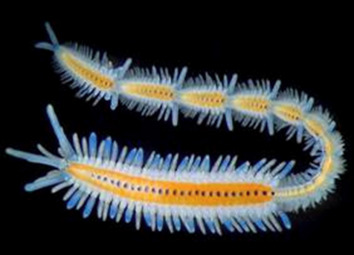
Class Polychaeta - Family Siboglinidae
170 species, marine (deep ocean)
Trophosome for symbionts - organ with beneficial bacteria
Reduced segmentation, seen in opisthosoma only (posterior, used for digging and as an anchor)
Anterior - beard of tentacles, used in gas exchange
Chitinous tube homes
Lack a digestive system, microvilli (cell projections) on tentacles
Most live in areas with hydrogen sulfide and methane, used for chemosynthesis
Trophosome has chemosynthetic bacteria, produce sugars for food
No reliance on light
Reproduction - dioecious
Trochophore larvae with digestive tract, used for dispersal
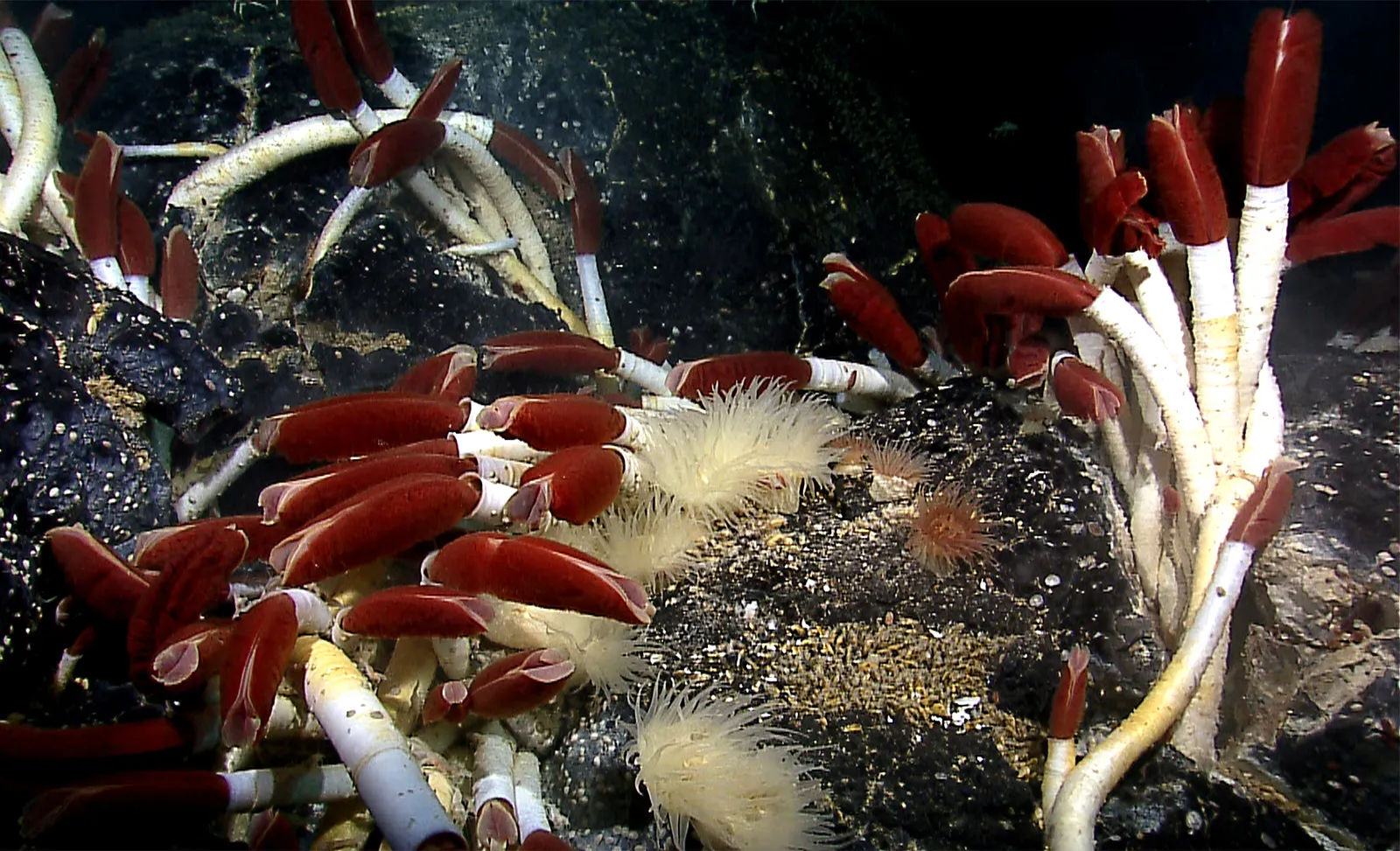
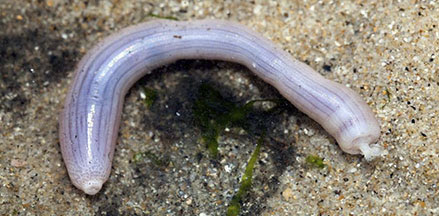
Class Echiura (Echiurans)
“Serpent-like”
Shall, marine, “sausage-like”
Extendable proboscis - ciliated, particles fall into the gutter and are then transported into the mouth
Complete digestive tract
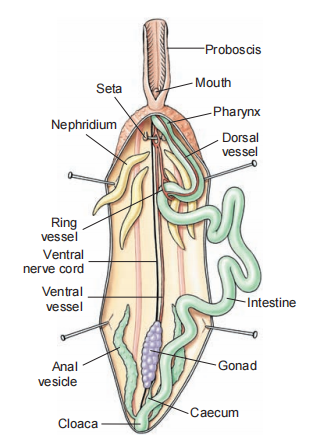
Class Echiura - Genus Urechis
Peristatic waves draw water into burrow
Ecosystem engineers, creation of burrows
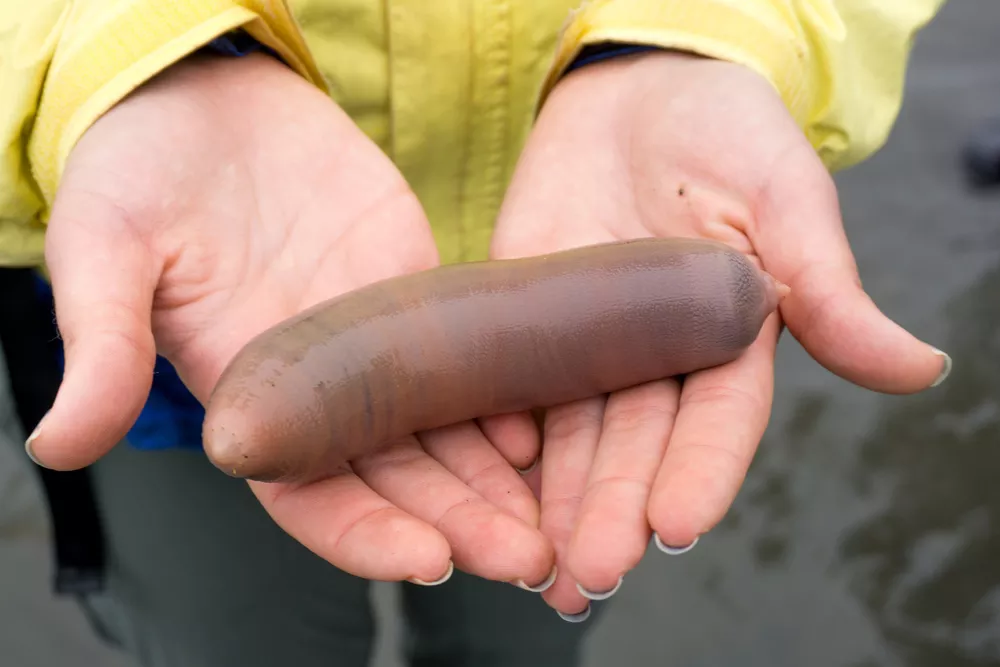
Class Clitellata
“Pack saddle”
85% are oligochaetes (subclass)
hermaphroditic
Clitellum - secretes cocoons for embryos, mucus used for sperm transfer, albumen for embryos (food source)
Permanent gonads
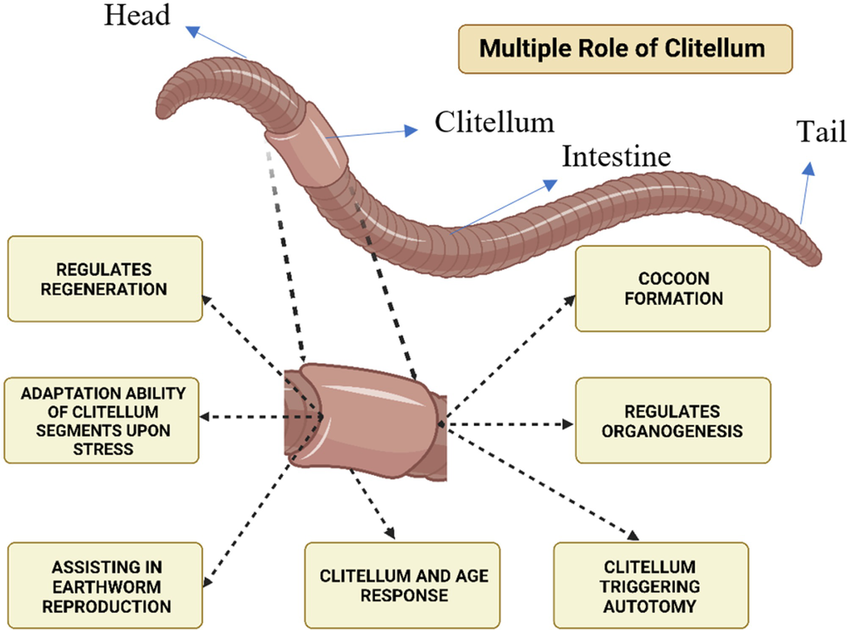
Subclass Oligochaeta (Oligochaetes)
“Few setae”
Freshwater/terrestrial
Earthworms = ecosystem engineers
No parapodia, few setae, reduced anterior sense organs, special respiratory structures
Set body plan
Segmented heart/circulatory system, use hemoglobin, segmented ganglia
Unsegmented digestive tract - crop, gizzard, intestine (typhlosole)
Locomotion - peristaltic waves, sequential contraction, circular/longitudinal muscle
Circular - forward
Longitudinal - anchor
Reproduction - testes/ovaries, mutual sperm transfer, received in spermathecae (all assisted by clitellum)
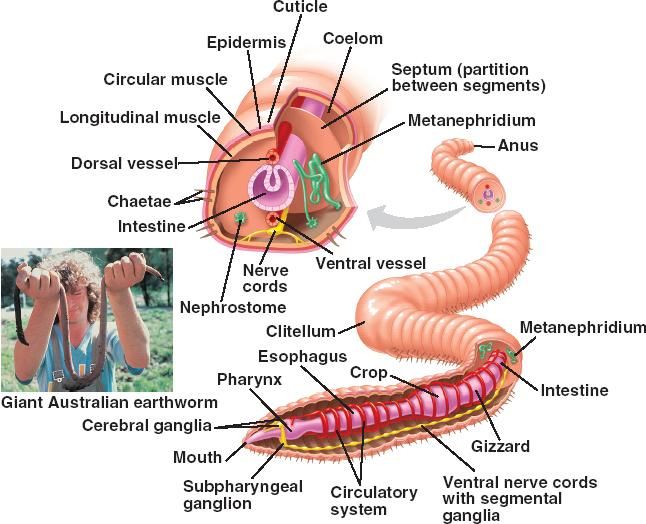
Subclass Hirudinea
Leeches
Freshwater, some terrestrial
Shared features with oligochaetes
Lack setae and septa - movement is different, suckers are used for an “inchworm” motion
Suckers adapted to attachment, reduced coelom - filled mesenchyme
Feeding/sucking proboscis
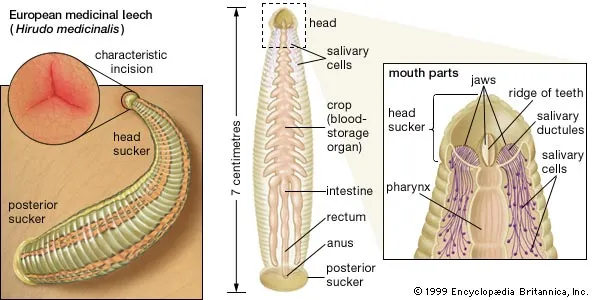
Phylum Nematoda
“Thread”
Diverse, simple body plan
Most abundant multi-cellular animals
Found everywhere
No circulatory system, respiratory, or excretory (use diffusion)
Ecdysozoa: “molting animals” - undecided classification
Nematode Features
Sensory amphids derived from cilia
Coverings and cavities:
No segmentation, tapered worms
Collagen forms outer cuticle, secreted by epidermis
Syncytial epidermis - has multiple nuclei
Crossways/trellis-like cuticle, inelastic fibers (rigid)
Ecdysis - molting
Molt cuticle, 4x over life
Each molt is unique
Growth between molts, grow by increasing cell size (eutelli)
Cavity - pseudocoelom
Mesoderm lines ectoderm, but not the endoderm
Pseudocoel - fluid performs circulation

Nematode Features 2
Locomotion - no circular muscles, no waves
Pressure in pseudocoel is high, stiff cuticle - roundworm
No locomotor cilia
Sinusoidal waves by longitudinal muscles - inefficient, requires a thick medium
Nervous - anterior nerve ring, nerve cords run down the body
Muscles connect to nervous cords, noncontractile segments
Ocelli
Anterior amphids, posterior phasmids = both lined with sensory hairs, chemoreceptors (detect pheromones)
Digestive tract - tube
Pharynx is highly pressurized, pumps fluid/food into the digestive tract, anus is sealed
Reproduction:
Dioecious, internal fertilization
Males have copulatory spicules, sperm enters the gonopore, sperm = amoeboid, crawls
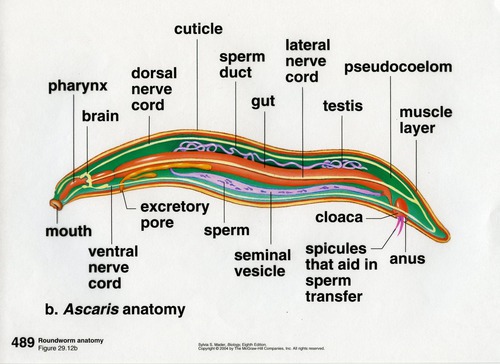
Phylum Arthropoda
“Jointed foot”
85% of all animals
Segmented, chitinous exoskeleton
Loss of mobile cilia
Segmentation - fusion to tagmata (distinct body segments), due to specialization
8 classes, over 80 orders, 2400 families
Arthropod Features
Exoskeleton - hard, external covering
Protects organs, aids in locomotion
Secreted by epidermis
Waxy outer layer = epicuticle
Inner layer = procuticle, chitinous
Exoskeleton hardens by “tanning” - sclerotization
Proteins are cross-linked
Procuticle = thick/thin sections for movement, forms joint-pairs of antagonizing muscles
Often includes resilin = spring-like protein, releases muscles
Hemocoel - used for circulation
Coelom doesn’t aid movement, is highly reduced
Molting - ecdysis
Growth occurs in spurts
Biomass - continuous
Old cuticle splits due to pressure, caused by fluid or gas
New cuticle forms before the split, not yet hardened
Circulatory:
Open system, hemolymph travels through vessels - hemocoel - heart with ostia
Vision:
Ocelli and/or compound eyes
Eye focuses light, nervous system monitors variation, processes image
Ommatidia, wide field of view
Reproduction - sexual/dioecious
Some parthenogenesis
Primarily internal fertilization